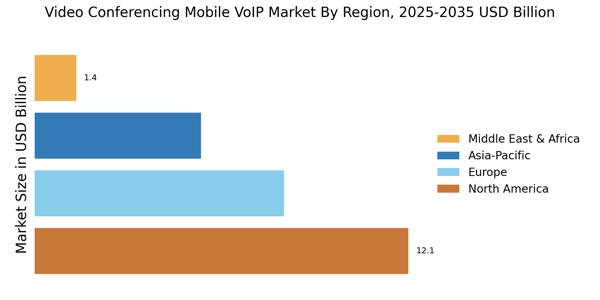The Video Conferencing Mobile VoIP Market is currently characterized by a dynamic competitive landscape, driven by rapid technological advancements and an increasing demand for seamless communication solutions. Major players such as Zoom Video Communications (US), Microsoft (US), and Cisco Systems (US) are at the forefront, each adopting distinct strategies to enhance their market positioning. Zoom Video Communications (US) continues to focus on innovation, particularly in enhancing user experience through AI-driven features, while Microsoft (US) leverages its extensive ecosystem to integrate Teams with other Microsoft services, thereby fostering user retention. Cisco Systems (US) emphasizes security and reliability, appealing to enterprise clients who prioritize data protection in their communications. Collectively, these strategies contribute to a competitive environment that is increasingly centered around user-centric innovations and integrated solutions.
In terms of business tactics, companies are increasingly localizing their operations to better serve regional markets, optimizing supply chains to enhance efficiency. The market structure appears moderately fragmented, with a mix of established players and emerging startups vying for market share. This fragmentation allows for diverse offerings, yet the influence of key players remains substantial, as they set benchmarks for quality and innovation that smaller companies often strive to meet.
In August 2025, Zoom Video Communications (US) announced the launch of a new AI-powered transcription feature aimed at enhancing accessibility for users with hearing impairments. This strategic move not only aligns with the growing emphasis on inclusivity but also positions Zoom as a leader in leveraging AI to improve user experience. Such innovations are likely to attract a broader user base, reinforcing Zoom's competitive edge in the market.
In September 2025, Microsoft (US) unveiled a partnership with a leading cybersecurity firm to bolster the security features of Microsoft Teams. This collaboration underscores Microsoft's commitment to providing a secure communication platform, which is increasingly critical as businesses navigate a landscape fraught with cyber threats. By enhancing security, Microsoft not only protects its users but also strengthens its value proposition against competitors.
In July 2025, Cisco Systems (US) expanded its Webex platform by integrating advanced analytics tools that provide users with insights into meeting effectiveness. This strategic enhancement reflects Cisco's focus on delivering value-added services that go beyond basic video conferencing, thereby appealing to organizations seeking to optimize their communication strategies. Such developments indicate a shift towards more sophisticated offerings that cater to the evolving needs of businesses.
As of October 2025, the competitive trends in the Video Conferencing Mobile VoIP Market are increasingly defined by digitalization, sustainability, and the integration of artificial intelligence. Strategic alliances are becoming more prevalent, as companies recognize the value of collaboration in enhancing their technological capabilities. Looking ahead, competitive differentiation is likely to evolve from traditional price-based competition to a focus on innovation, technological advancements, and the reliability of supply chains. This shift suggests that companies that prioritize these aspects will be better positioned to thrive in an increasingly competitive landscape.


















Leave a Comment